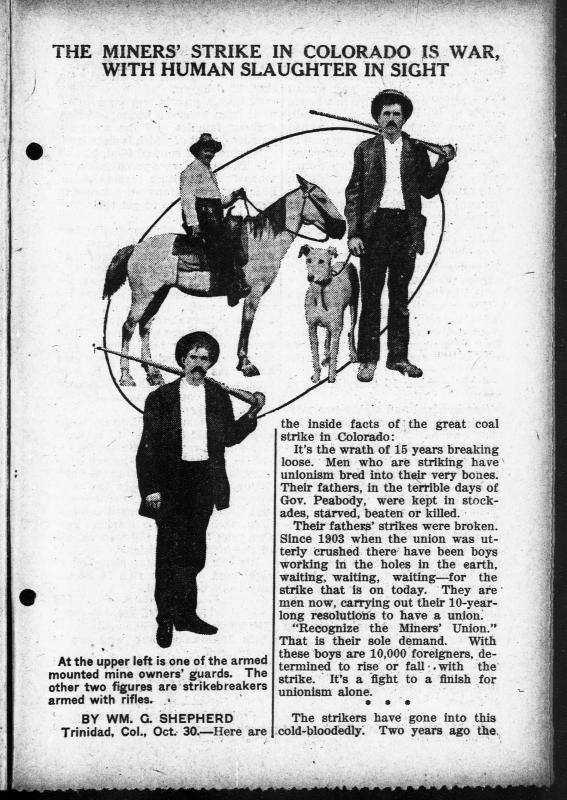|
Moderated by NW Okie! |
Volume 16 , Issue 192014Weekly eZine: (374 subscribers)Subscribe | Unsubscribe Using Desktop... |
Miner's Strike In Colorado

It was 30 October 1913, page 27 of The Day Book, we find "The Miner's Strike in Colorado Is War, With Human Slaughter In Sight," written by Wm. G. Shepherd, Trinidad, Colorado, October 30, 1913.
Here are the inside facts of the great coal strike in Colorado:
It's the wrath of 15 years breaking loose. Men who were striking had unionism bred into their very bones. Their fathers, in the terrible days of Gov. Peabody, were kept in stockades, starved, beaten or killed.
Their fathers' strikes were broken. Since 1903 when the union was utterly crushed there had been boys working the holes in the earth, waiting, waiting, waiting, for the strike that was on that day. They were men now, carrying out their 10-year long resolutions to have a union.
"Recognize the Miners' Union." That was their sole demand. With these boys were 10,000 foreigners, determined to rise or fall with the strike. It was a fight to a finish for unionism alone.
The strikers had gone into this cold-bloodedly. Two years before (1911) the United Mine Workers of America began secretly organizing the men. The organization brought hope to the miner who worked on land owned by the company; who lived in a house owned by the company; whose children were taught in a school owned by the company; who got his mail at a post office owned by the company; who bought his food at a store owned by the company; who was tended in his sickness by a doctor owned by the company, and who, himself, was owned, body and soul, by the company. Early in September 1911 the iron seemed hot.
The miners were told by union leaders that they would have to leave their company owned homes and live in tents. The miners said, "Get us the tents."
The union leaders began to prepare. secretly they rented patches of ground; secretly shipped from West Virginia, where they had been used in the strikes there, hundreds of tents. By September 15, 1913 everything was ready.
One hundred and eighty-two miners' delegates met. They invited the mine owners. The mine owners refused. These delegates held an experience meeting. They told how the mine owners disregarded human life.
One man told how a company doctor had accidentally destroyed one of his eyes. Another told how a man, one side of his face caved in, stretched out in a blacksmith shop, with dirty oil-soaked waste, laid on his cheek, oil oozing through the wound into his mouth, had spent five hours dying. Another told how a man, with both legs nipped off by a giant cable, had been forced by a company doctor to sign a statement releasing the company from all blame, on penalty of being put out of the company hospital.
One man said, "Ten pounds of coal was worth more than the life of any one of us."
And so they voted to strike. On September 23, 1913, it began. Company guards, carrying guns, went from house to house, ordering strikers' families off the company premises, most of which was state land.
It rained and snowed September 23 and 24, 1913.Those who were permitted to remove their furniture formed pitiful little corteges. Many were forced to appeal to the state to get their own household things.
Ten thousand strikers, with their families were then living in tents, with winter at hand. Each married man got $4 a week from the Untied Mine Workers, with 50 cents a week for each child. Unmarried strikers received $3 a week. It would cost $100,000 a week to keep the strike going back in 1913.
The strikers were picketing. There had been three battles with, perhaps, ten men killed. The union men had guns and revolvers and ammunition. So had the 800 guards, hired by the company, most of whom were deputy sheriffs.
The Colorado Fuel & Iron Co. was the leader against the men. L. M. Bowers, a direct representative of Standard Oil, on the board of the fuel company, was in Denver, directing the fight.
One of the first moves the mine owners made was to construct several "battle ships," armored automobiles, each carrying a machine gun. One "ship" had already fired on one of the four tented cities.
It was reported as a war, with human slaughter in sight, and merciless, rich 26 Broadway to be conquered.
| View or Add Comments (0 Comments)
| Receive
updates ( subscribers) |
Unsubscribe
| © . Linda Mcgill Wagner - began © 1999 Contact Me | |
